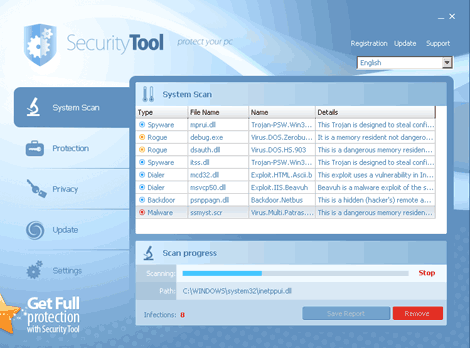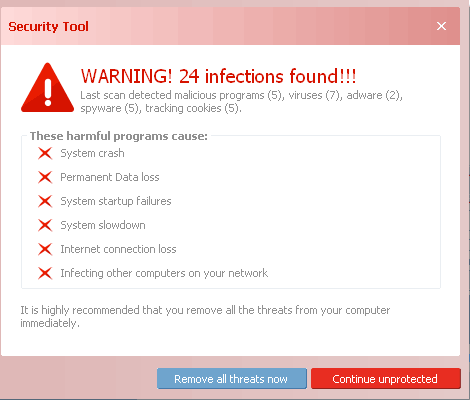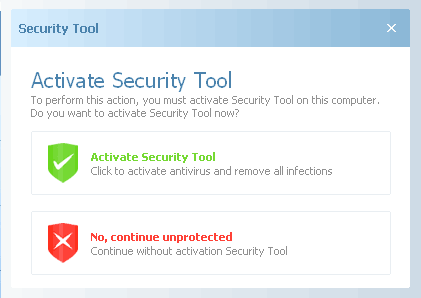TROJ_FAKEAV.ZKQ
SecurityToolFraud!Gen4 (Symantec); VirTool:Win32/Obfuscator.JL (Microsoft); Mal/FakeAV-EE (Sophos)
Windows 2000, XP, Server 2003


Threat Type: Trojan
Destructiveness: No
Encrypted: No
In the wild: Yes
OVERVIEW
This Trojan may be downloaded by other malware/grayware/spyware from remote sites. It may be dropped by other malware. It may be unknowingly downloaded by a user while visiting malicious websites.
It displays fake alerts that warn users of infection. It also displays fake scanning results of the affected system. It then asks for users to purchase it once scanning is completed. If users decide to purchase the rogue product, users are directed to a certain website asking for sensitive information, such as credit card numbers.
TECHNICAL DETAILS
1,208,832 bytes
PE
Yes
25 Nov 2010
Drops files, Connects to URLs/Ips
Arrival Details
This Trojan may be downloaded by other malware/grayware/spyware from remote sites.
It may be dropped by other malware.
It may be unknowingly downloaded by a user while visiting malicious websites.
Installation
This Trojan drops the following files:
- %User Profile%\Start Menu\Programs\Security Tool.lnk - shortcut to the dropped copy
(Note: %User Profile% is the current user's profile folder, which is usually C:\Windows\Profiles\{user name} on Windows 98 and ME, C:\WINNT\Profiles\{user name} on Windows NT, and C:\Documents and Settings\{user name} on Windows 2000, XP, and Server 2003.)
It drops the following copies of itself into the affected system:
- %Application Data%\{random numbers}.exe
(Note: %Application Data% is the current user's Application Data folder, which is usually C:\Windows\Profiles\{user name}\Application Data on Windows 98 and ME, C:\WINNT\Profiles\{user name}\Application Data on Windows NT, and C:\Documents and Settings\{user name}\Local Settings\Application Data on Windows 2000, XP, and Server 2003.)
Autostart Technique
This Trojan adds the following registry entries to enable its automatic execution at every system startup:
HKEY_CURRENT_USER\Software\Microsoft\
Windows\CurrentVersion\RunOnce
{random numbers} = %Application Data%\{random numbers}.exe
Other Details
This Trojan does the following:
- If users decide to purchase the rogue product, users are directed to the following sites asking for sensitive information, such as credit card numbers:
- http://{BLOCKED}trapay.com/buy.php
- http://{BLOCKED}.{BLOCKED}.171.35/cb_soft.php
- http://{BLOCKED}payform.biz/buy.php
- Upon execution, it displays the following graphical user interface (GUI):



- It may gather the following information if the user chooses to activate the product:
- Credit card information such as card type, card number, expiration date, name
- Contact information such as email, country, address, phone number
Rogue Antivirus Routine
This Trojan displays fake alerts that warn users of infection. It also displays fake scanning results of the affected system. It then asks for users to purchase it once scanning is completed. If users decide to purchase the rogue product, users are directed to a certain website asking for sensitive information, such as credit card numbers.
SOLUTION
8.900
7.650.06
25 Nov 2010
11/25/2010 12:00:00 AM
Step 1
For Windows XP and Windows Server 2003 users, before doing any scans, please make sure you disable System Restore to allow full scanning of your computer.
Step 2
Identify and terminate files detected as TROJ_FAKEAV.ZKQ
- If the detected file is displayed in either Windows Task Manager or Process Explorer but you cannot delete it, restart your computer in safe mode. To do this, refer to this link for the complete steps.
- If the detected file is not displayed in either Windows Task Manager or Process Explorer, continue doing the next steps.
Step 3
Delete this registry value
Important: Editing the Windows Registry incorrectly can lead to irreversible system malfunction. Please do this step only if you know how or you can ask assistance from your system administrator. Else, check this Microsoft article first before modifying your computer's registry.
- In HKEY_CURRENT_USER\Software\Microsoft\Windows\CurrentVersion\RunOnce
- {random numbers} = %Application Data%\{random numbers}.exe
- {random numbers} = %Application Data%\{random numbers}.exe
Step 4
Search and delete this file
Step 5
Scan your computer with your Trend Micro product to delete files detected as TROJ_FAKEAV.ZKQ. If the detected files have already been cleaned, deleted, or quarantined by your Trend Micro product, no further step is required. You may opt to simply delete the quarantined files. Please check this Knowledge Base page for more information.
Did this description help? Tell us how we did.

